Design, Implementation, and Evaluation of an Immersive Virtual Reality-Based Educational Game for Learning Topology Relations at Schools: A Case Study
Abstract
:1. Introduction
2. Literature Review
2.1. VR Learning Environment (VRLE)
2.2. VR Game-Based LE
2.3. Current State of the Research Field
3. Methodology
3.1. Purpose of the Study
- Design and implement an IVREG benefiting from Deep Learning for learning geospatial topics;
- Examine the performance of integrating inquiry-based learning and instruction through observation in IVREG;
- Evaluate the usability of VR and Gamification in learning environments compared to traditional learning environments;
- Examine the implemented IVREG;
- Assess the IVREG potential as a useful tool for teaching geospatial topics in K–12 grades.
3.2. Participants and Equipment
3.3. Materials
3.4. Design and Implementation
3.5. Procedure (and the Gameplay Mechanic)
4. Results and Discussion
4.1. Learning Perspective
4.2. VR Perspective
4.3. Educational Game Perspective
4.4. Playability
5. Conclusions
5.1. Implications
5.2. Limitations
Author Contributions
Funding
Institutional Review Board Statement
Informed Consent Statement
Data Availability Statement
Conflicts of Interest
Appendix A. Playability Questionnaire (PQ)
- I can play the game for a long time.
- If someone calls my name, I do not notice.
- I do not comprehend what people are talking about around me.
- The tasks in the game are meaningful.
- Exploring the scene is fascinating.
- Escaping the room is exciting.
- I play well with the help of the tutorial of the game.
- I feel motivated to use VR educational games more often.
- The game is appropriate enough to be used in schools.
- I better understand the topology relations by using this game.
- The learning part of the game is noticeable.
- Being in a virtual environment is not scary.
- I lose track of my position in the classroom.
- I do not feel motion sickness during the game.
- Playing VR is not tiring for the eyes.
- The game feels immersive.
- Wearing the headset does not make me uncomfortable.
References
- Elstad, E. Digital Expectations and Experiences in Education; Springer: Rotterdam, The Netherlands, 2016. [Google Scholar]
- Kamińska, D.; Sapiński, T.; Wiak, S.; Tikk, T.; Haamer, R.E.; Avots, E.; Helmi, A.; Ozcinar, C.; Anbarjafari, G. Virtual Reality and Its Applications in Education: Survey. Information 2019, 10, 318. [Google Scholar] [CrossRef] [Green Version]
- Liou, W.-K.; Chang, C.-Y. Virtual reality classroom applied to science education. In Proceedings of the 2018 23rd International Scientific-Professional Conference on Information Technology (IT), Zabljak, Montenegro, 19–24 February 2018; pp. 1–4. [Google Scholar]
- Chen, X.; Gao, Y. Application and Innovation of Using Virtual Reality in Art Education. In Proceedings of the 9th International Conference on Education and Management (ICEM 2019), Tsuru, Japan, 25–27 October 2019. [Google Scholar]
- Fällman, D.; Backman, A.; Holmlund, K. VR in education: An introduction to multisensory constructivist learning en-vironments. In Proceedings of the Conference on University Pedagogy, Umea University, Umea, Sweden, 18–19 February 1999. [Google Scholar]
- Garris, R.; Ahlers, R.; Driskell, J.E. Games, Motivation, and Learning: A Research and Practice Model. Simul. Gaming 2002, 33, 441–467. [Google Scholar] [CrossRef]
- Cimons, M. Geospatial Technology as a Core Tool: Impacts Everything from Navigating to Law Enforcement. Published in US News and World Report. 2011. Available online: https://www.yumpu.com/en/document/view/37151814/geospatial-technology-as-a-core-tool-us-news-and-world-report (accessed on 1 September 2021).
- Lee, V.W.; Hodgson, P.; Chan, C.-S.; Fong, A.; Cheung, W.L. Optimising the learning process with immersive virtual reality and non-immersive virtual reality in an educational environment. Int. J. Mob. Learn. Organ. 2020, 14, 21–35. [Google Scholar] [CrossRef]
- Slater, M. Implicit Learning Through Embodiment in Immersive Virtual Reality; Springer: Singapore, 2017; pp. 19–33. [Google Scholar]
- Vergara, D.; Rubio, M.P.; Lorenzo, M. On the Design of Virtual Reality Learning Environments in Engineering. Multimodal. Technol. Interact. 2017, 1, 11. [Google Scholar] [CrossRef] [Green Version]
- Lin, J.-W.; Duh, H.; Parker, D.; Abi-Rached, H.; Furness, T. Effects of field of view on presence, enjoyment, memory, and simulator sickness in a virtual environment. In Proceedings of the IEEE Virtual Reality 2002, Orlando, FL, USA, 24–28 March 2002; IEEE: New York, NY, USA, 2003; pp. 164–171. [Google Scholar]
- Cavazza, M.; Charles, F.; Mead, S.J. Developing Re-Usable Interactive Storytelling Technologies; Springer: Singapore, 2008; Volume 156, pp. 39–44. [Google Scholar]
- Steuer, J. Defining Virtual Reality: Dimensions Determining Telepresence. J. Commun. 1992, 42, 73–93. [Google Scholar] [CrossRef]
- Tsivitanidou, O.E.; Georgiou, Y.; Ioannou, A. A Learning Experience in Inquiry-Based Physics with Immersive Virtual Reality: Student Perceptions and an Interaction Effect Between Conceptual Gains and Attitudinal Profiles. J. Sci. Educ. Technol. 2021, 30, 841–861. [Google Scholar] [CrossRef]
- Bouta, H.; Retalis, S. Enhancing primary school children collaborative learning experiences in maths via a 3D virtual environment. Educ. Inf. Technol. 2012, 18, 571–596. [Google Scholar] [CrossRef]
- Karaoğlan Yılmaz, F.G.; Yılmaz, R.; Kılıç, A.E. Examination of digital game habits of high school students. In Proceedings of the International Child and Information Safety Congress, Ankara, Turkey, 11—13 April 2018. [Google Scholar]
- Chassiakos, Y.R.; Radesky, J.; Christakis, D.; Moreno, M.A.; Cross, C. Children and Adolescents and Digital Media. Am. Acad. Pediatrics 2016, 138, e20162593. [Google Scholar] [CrossRef] [PubMed] [Green Version]
- Liu, M.; Rosenblum, J.A.; Horton, L.; Kang, J. Designing Science Learning with Game-Based Approaches. Comput. Sch. 2014, 31, 84–102. [Google Scholar] [CrossRef]
- Shin, N.; Sutherland, L.M.; Norris, C.A.; Soloway, E. Effects of game technology on elementary student learning in mathematics. Br. J. Educ. Technol. 2011, 43, 540–560. [Google Scholar] [CrossRef] [Green Version]
- Virvou, M.; Katsionis, G.; Manos, K. Combining software games with education: Evaluation of its educational effectiveness. J. Educ. Technol.Soc. 2005, 8, 54–65. [Google Scholar]
- Giannakos, M. Enjoy and learn with educational games: Examining factors affecting learning performance. Comput. Educ. 2013, 68, 429–439. [Google Scholar] [CrossRef]
- Bourgonjon, J.; Valcke, M.; Soetaert, R.; Schellens, T. Students’ perceptions about the use of video games in the classroom. Comput. Educ. 2010, 54, 1145–1156. [Google Scholar] [CrossRef]
- Chittaro, L.; Buttussi, F. Assessing Knowledge Retention of an Immersive Serious Game vs. a Traditional Education Method in Aviation Safety. IEEE Trans. Vis. Comput. Graph. 2015, 21, 529–538. [Google Scholar] [CrossRef]
- Boyle, E.; Connolly, T.M.; Hainey, T. The role of psychology in understanding the impact of computer games. Entertain. Comput. 2011, 2, 69–74. [Google Scholar] [CrossRef]
- Maitem, J. Math World: A Game-Based 3D Virtual Learning Environment (3D VLE) for Second Graders. Int. J. Multimedia Its Appl. 2012, 4, 1–13. [Google Scholar] [CrossRef]
- Udeozor, C.; Toyoda, R.; Abegão, F.R.; Glassey, J. Perceptions of the use of virtual reality games for chemical engineering education and professional training. High. Educ. Pedagog. 2021, 6, 175–194. [Google Scholar] [CrossRef]
- Ricker, A.A.; Richert, R.A. Digital gaming and metacognition in middle childhood. Comput. Hum. Behav. 2021, 115, 106593. [Google Scholar] [CrossRef]
- Torner, J.; Alpiste, F.; Brigos, M. Virtual Reality Application to Improve Spatial Ability of Engineering Students. 2016. Available online: https://upcommons.upc.edu/bitstream/handle/2117/97244/vr_spatial.pdf (accessed on 1 September 2021).
- Molina-Carmona, R.; Pertegal-Felices, M.; Jimeno-Morenilla, A.; Mora-Mora, H. Assessing the impact of virtual reality on engineering students’ spatial ability. In The Future of Innovation and Technology in Education: Policies and Practices for Teaching and Learning Excellence; Jimeno-Morenilla, A., Ed.; Emerald Publishing Limited: Bingley, UK, 2018. [Google Scholar]
- Bednarz, S.; Heffron, S.; Huynh, N. A road map for 21st century geography education. Geography Education Research (A Report from the Geography Education Research Committee of the Road Map for 21st Century Geography Education Project). Available online: http://gisgeo.org/assets/files/NGS_RoadMapConcept_GERC_07.pdf (accessed on 1 September 2021).
- Schlemper, M.B.; Athreya, B.; Czajkowski, K.; Stewart, V.C.; Shetty, S. Teaching Spatial Thinking and Geospatial Technologies Through Citizen Mapping and Problem-Based Inquiry in Grades 7-12. J. Geogr. 2018, 118, 21–34. [Google Scholar] [CrossRef]
- Zlatanova, S. Topological Relationships and Their Use, in Encyclopedia of GIS; Springer International Publishing: Cham, Switzerlandm, 2015; pp. 1–21. [Google Scholar]
- Shakirova, N.D.; Al Said, N.; Konyushenko, S.M. The Use of Virtual Reality in Geo-Education. Int. J. Emerg. Technol. Learn. (iJET) 2020, 15, 59–70. [Google Scholar] [CrossRef]
- Hagge, P. Student Perceptions of Semester-Long In-Class Virtual Reality: Effectively Using “Google Earth VR” in a Higher Education Classroom. J. Geogr. High. Educ. 2020, 45, 1–19. [Google Scholar] [CrossRef]
- Guzsvinecz, T.; Orbán-Mihálykó, É.; Perge, E.; Sik-Lányi, C. Analyzing the Spatial Skills of University Students with a Virtual Reality Application using a Desktop Display and the Gear VR. Acta Polytech. Hung. 2020, 17, 35–56. [Google Scholar] [CrossRef]
- Anderman, L.H.; Midgley, C. Motivation and middle school students. In What Current Research Says to the Middle Level Practitioner; Irvin, J.L., Ed.; National Middle School Association: Columbus, OH, USA, 1997; Volume 26, pp. 325–346. [Google Scholar]
- Wigfield, A.; Eccles, J.S. Students’ Motivation During the Middle School Years. In Improving Academic Achievement; Elsevier: Amsterdam, The Netherlands, 2002; pp. 159–184. [Google Scholar]
- Schell, J. The Art of Game Design: A Book of Lenses; CRC Press: Boca Raton, FL, USA, 2008. [Google Scholar]
- David, D.; Edwin; Arman, E.; Hikari; Chandra, N.; Nadia, N. Development of Escape Room Game using VR Technology. Procedia Comput. Sci. 2019, 157, 646–652. [Google Scholar] [CrossRef]
- Martirosov, S.; Kopecek, P. Virtual Reality and its Influence on Training and Education—Literature Review. In Proceedings of the DAAAM Proceedings; DAAAM International: Vienna, Austria, 2017; pp. 0708–0717. [Google Scholar]
- Griffiths, M.D.; Kuss, J.D.; King, D.L. Video game addiction: Past, present and future. Curr. Psychiatry Rev. 2012, 8, 308–318. [Google Scholar] [CrossRef] [Green Version]
- Shi, A.; Wang, Y.; Ding, N. The Effect of Game–Based Immersive Virtual Reality Learning Environment on LearningOut-Comes: Designing an Intrinsic Integrated Educational Game for Pre–Class Learning. Interactive Learning Environments. 2019. Available online: https://www.tandfonline.com/doi/citedby/10.1080/10494820.2019.1681467?scroll=top&needAccess=true (accessed on 1 September 2021). [CrossRef]
- Bandura, A.; Bryant, J.; Zillmann, D. Social cognitive theory of mass communication. In Media Effects: Advances in Theory and Research; Routledge: London, UK, 2002; pp. 94–124. [Google Scholar]
- Maiti, S.K.; Ghosh, D. Plant–soil interactions as a restoration tool. In Climate Change and Soil Interactions; Prasad, M.N.V., Pie-trzykowski, M., Eds.; Elsevier: Amsterdam, The Netherlands, 2020; pp. 689–730. [Google Scholar]
- Chiang, T.H.; Yang, S.J.; Hwang, G.-J. Students’ online interactive patterns in augmented reality-based inquiry activities. Comput. Educ. 2014, 78, 97–108. [Google Scholar] [CrossRef]
- Ibáñez, M.-B.; Delgado-Kloos, C. Augmented reality for STEM learning: A systematic review. Comput. Educ. 2018, 123, 109–123. [Google Scholar] [CrossRef]
- Kaye, L. Young Children in a Digital Age: Supporting Learning and Development with Technology in Early Years. Routledge: London, UK, 2016. [Google Scholar]
- Feng, Z.; González, V.A.; Amor, R.; Lovreglio, R.; Cabrera-Guerrero, G. Immersive virtual reality serious games for evacuation training and research: A systematic literature review. Comput.Educ. 2018, 127, 252–266. [Google Scholar] [CrossRef] [Green Version]
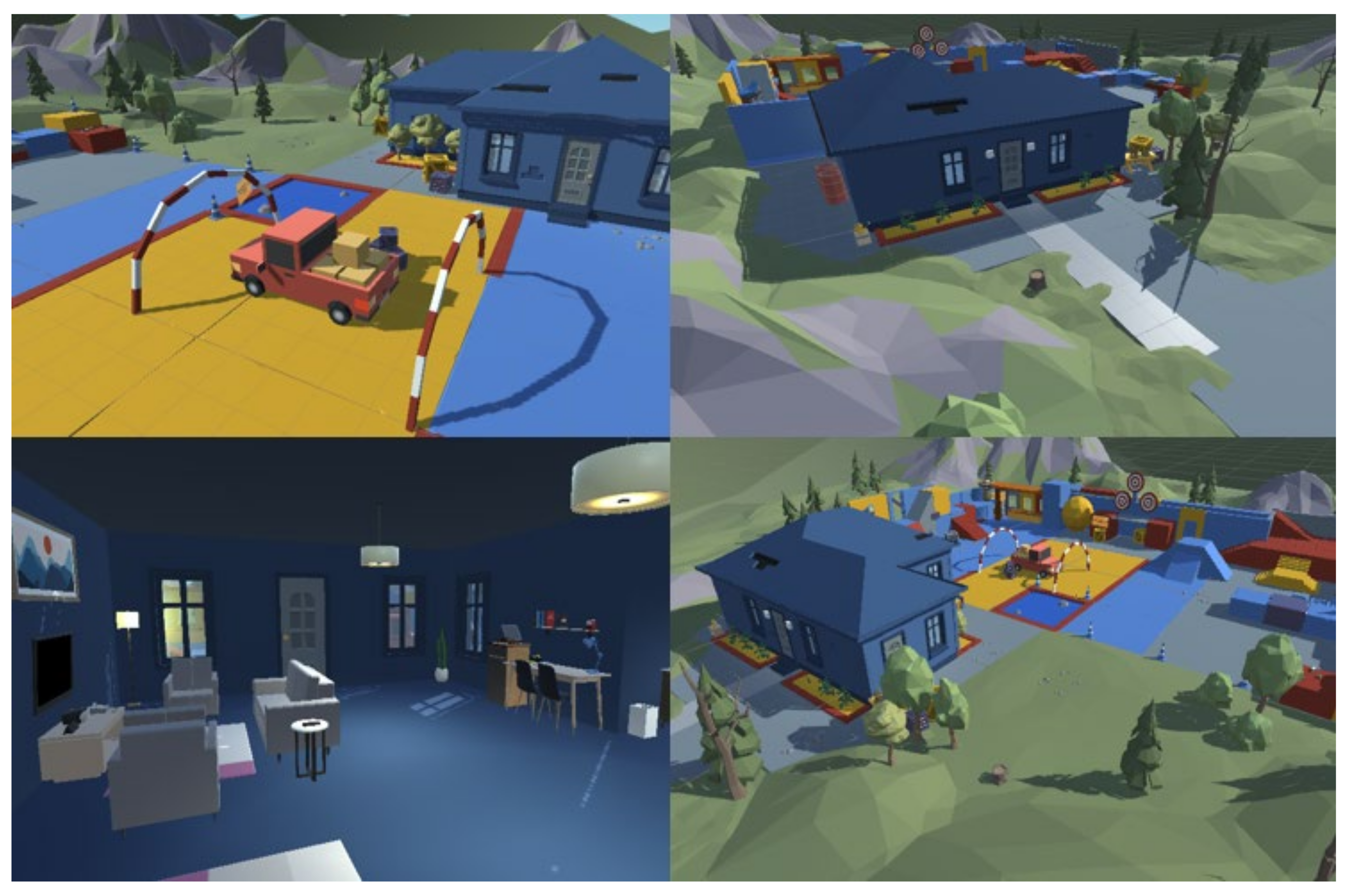
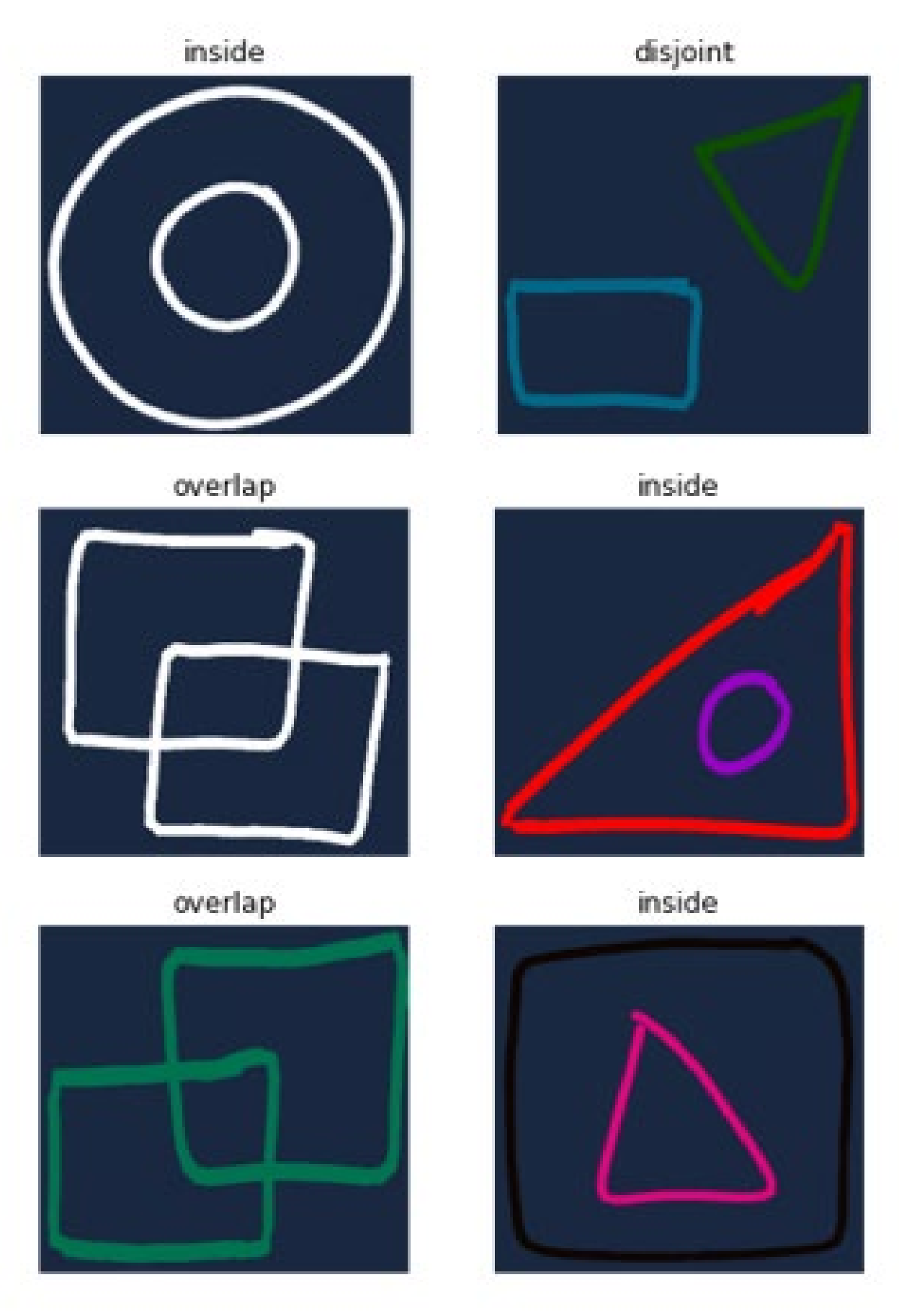
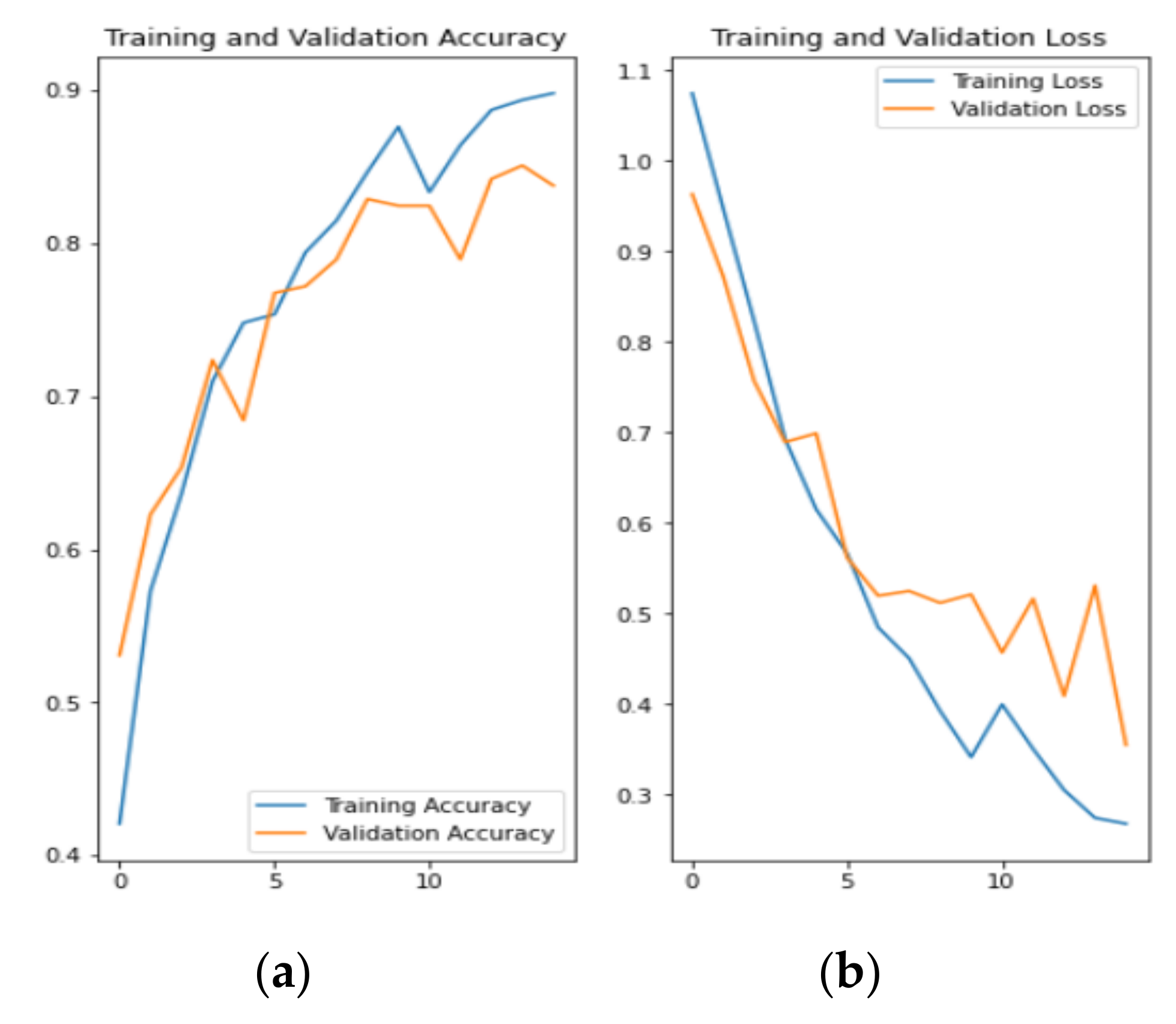

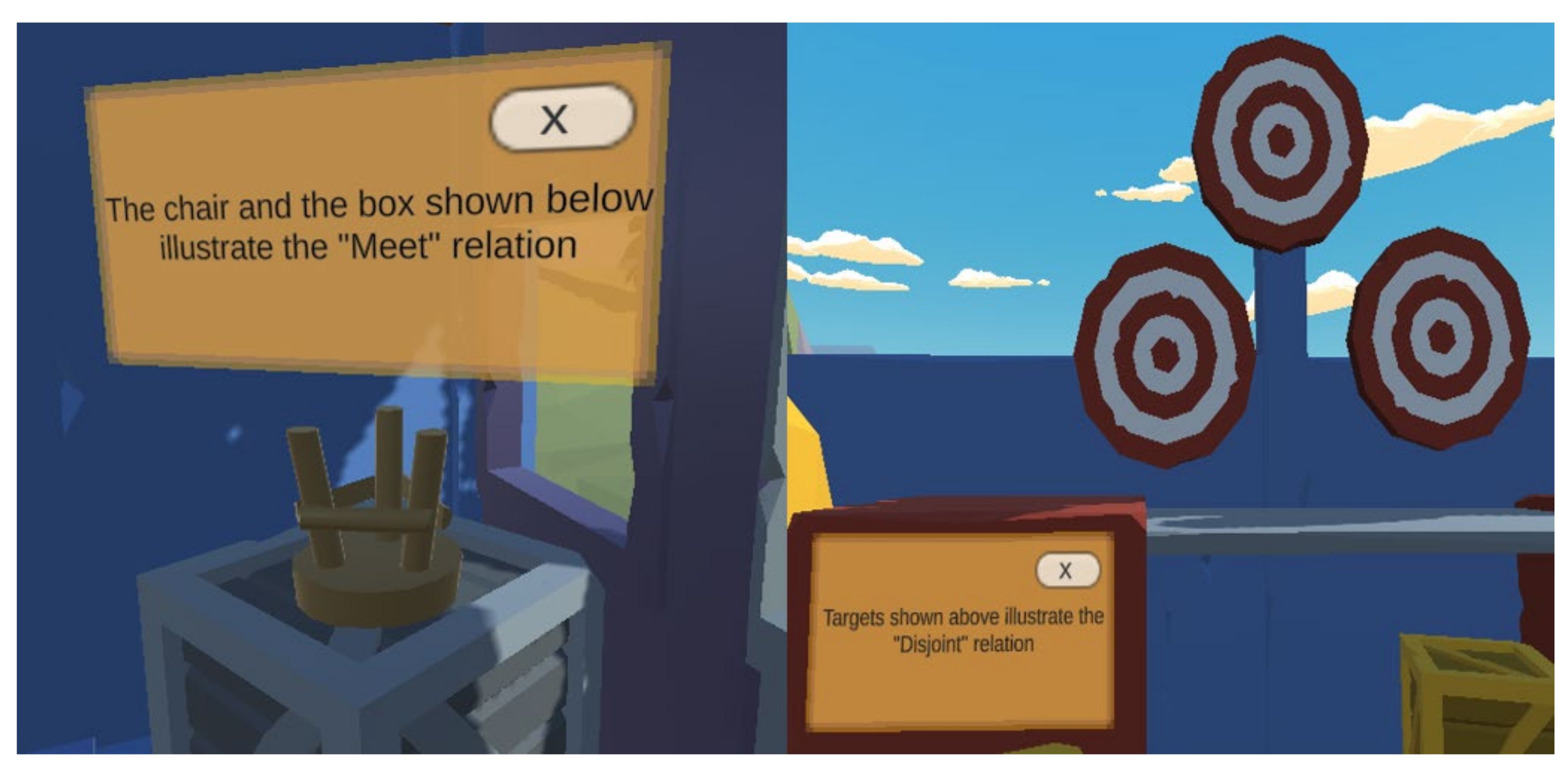
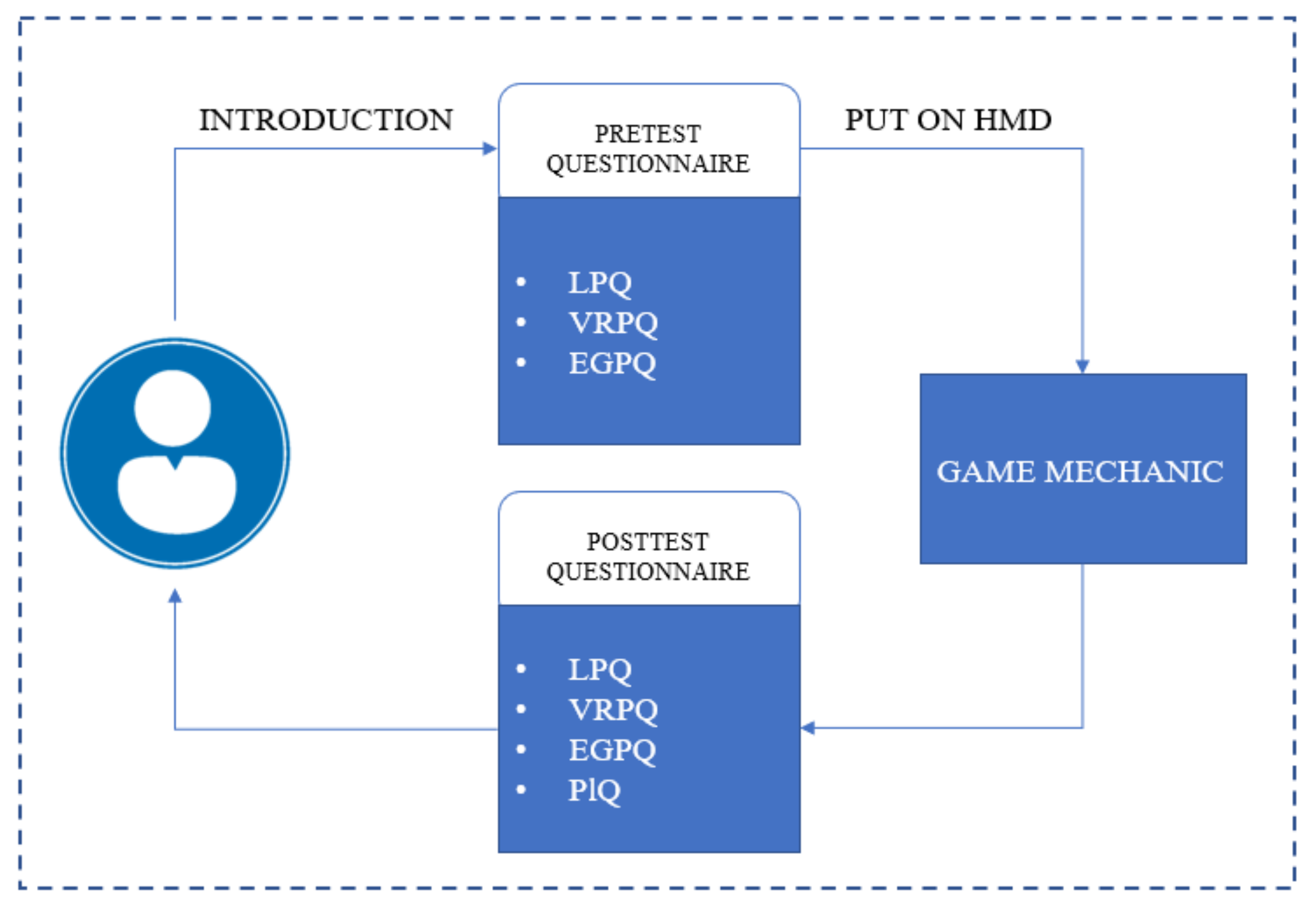
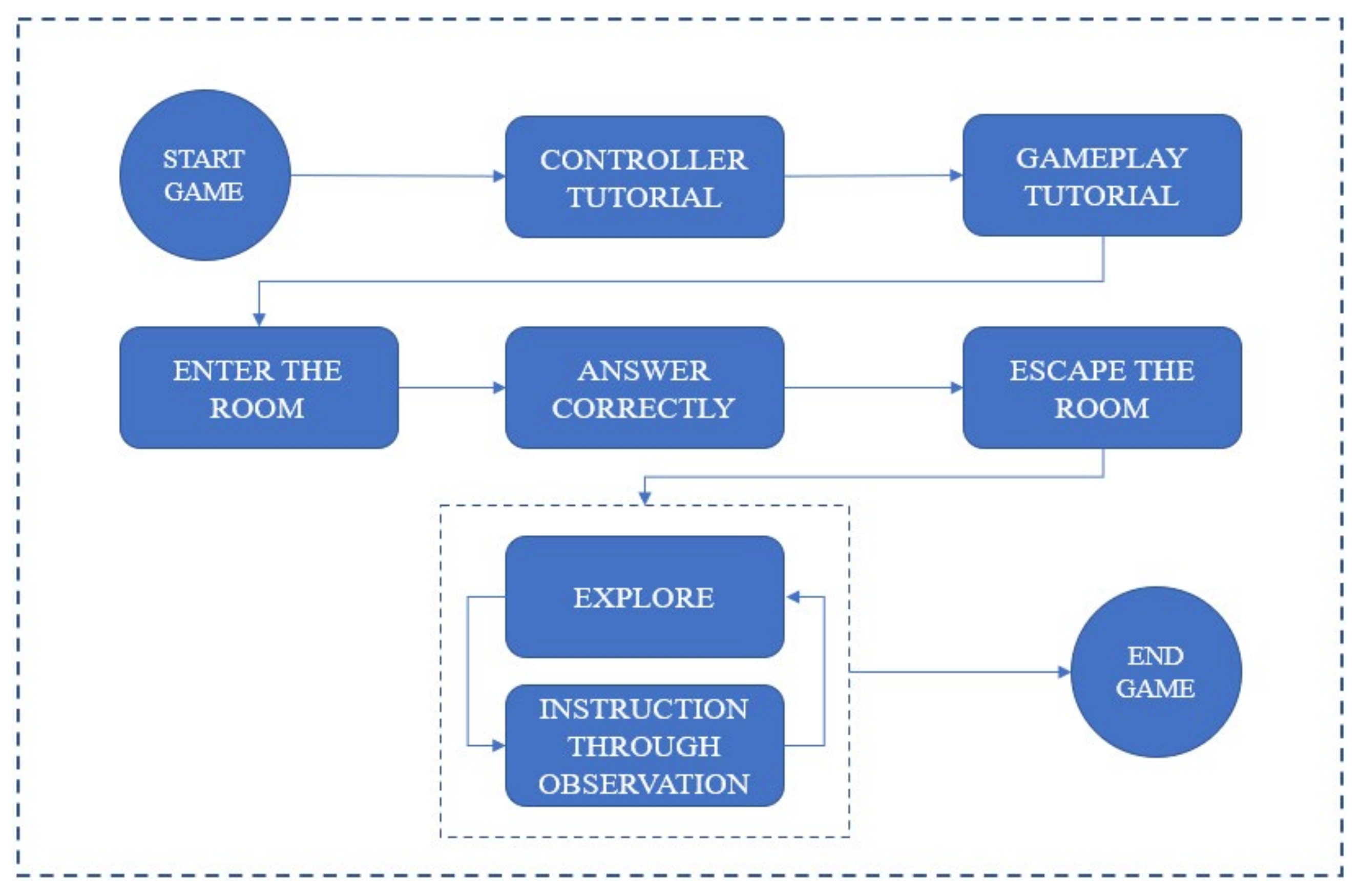


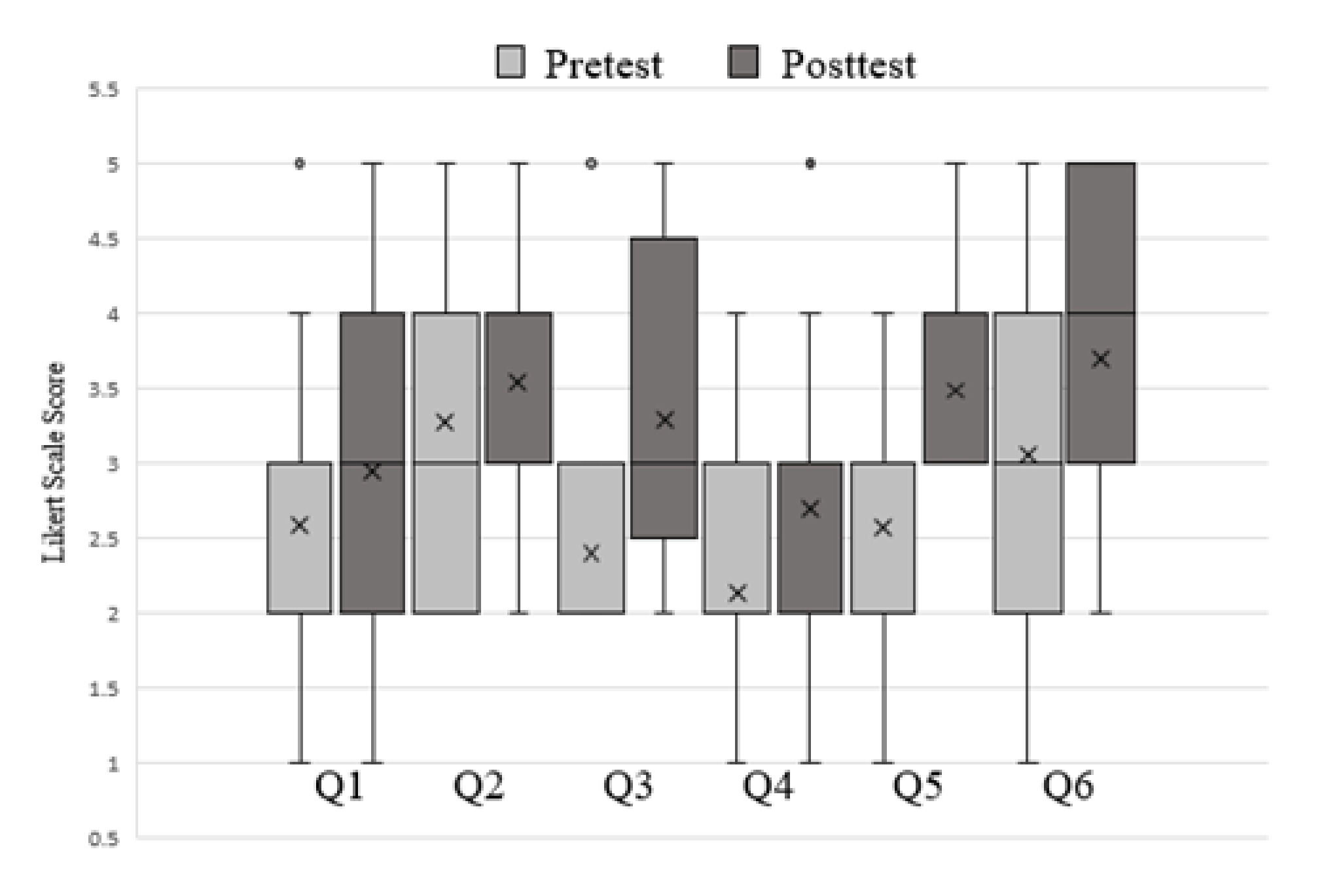
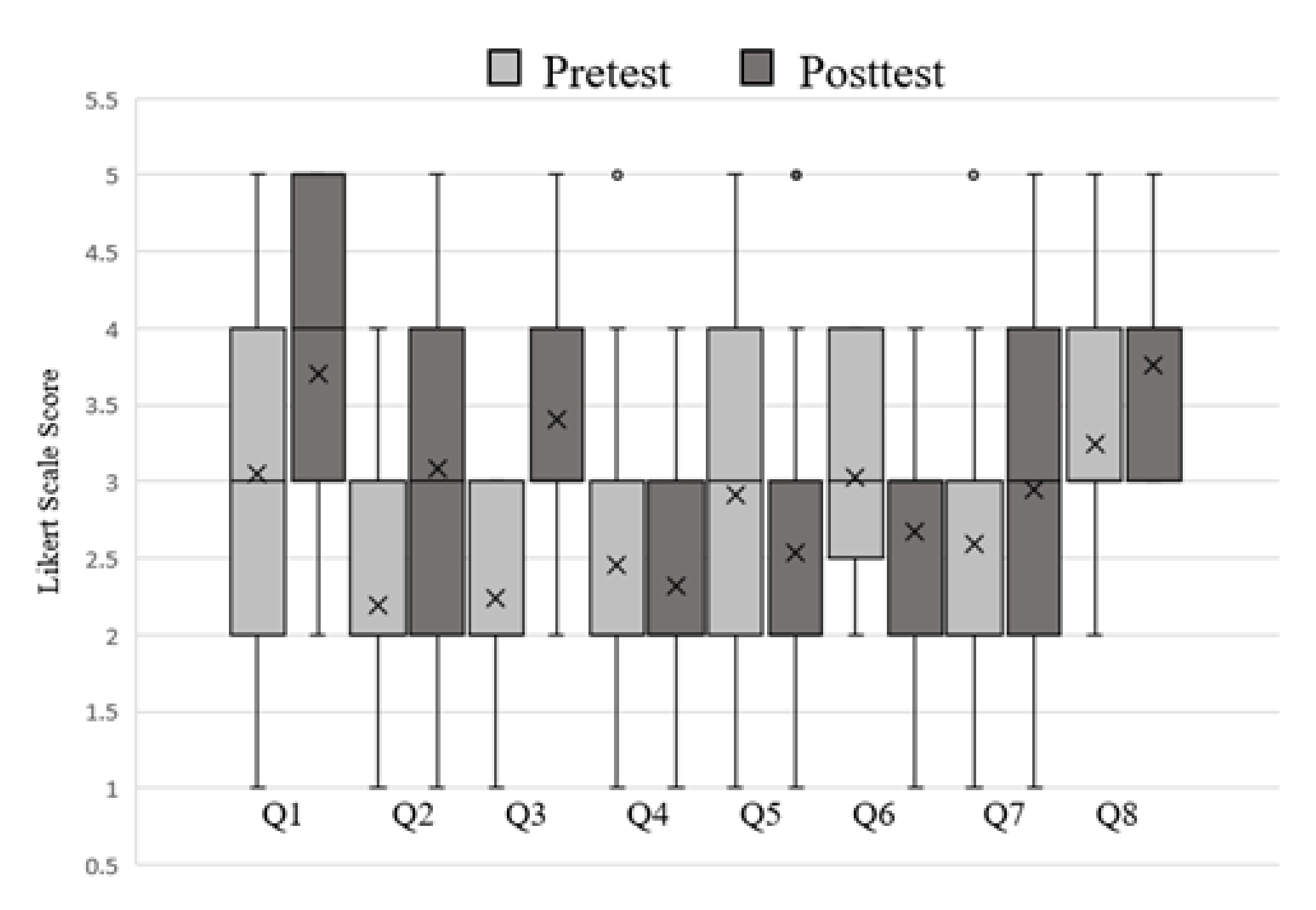

| Id | Item |
|---|---|
| Q1 | I am interested in learning topology relations. |
| Q2 | It is necessary to learn geospatial topics. |
| Q3 | Learning topology relations is easy at the moment. |
| Q4 | I easily notice the relationships between objects in my surroundings. |
| Q5 | Instruction through observation is effective. |
| Q6 | The integration of inquiry-based learning and VR games is effective. |
| Id | Item |
|---|---|
| Q1 | Virtual Reality (VR) is useful in classrooms. |
| Q2 | VR develops students’ creativity. |
| Q3 | VR is useful in teaching geospatial topics. |
| Q4 | VR is solely instructive enough and the presence of teachers is not required. |
| Q5 | Students using VR pay attention only to the entertainment parts. |
| Q6 | Students feel unconfident to use VR in classrooms. |
| Q7 | VR is more effective compared to looking at 2D presentations. |
| Q8 | VR is likely to be used in school frequently in the near future. |
| Id | Item |
|---|---|
| Q1 | I would like to play educational games at school. |
| Q2 | Educational games enhance the process of passing down knowledge. |
| Q3 | Educational games stifle students’ creativity. |
| Q4 | Educational games are easy to understand and use. |
| Q5 | Educational games increase student motivation. |
| Dimensions | Mean | Std | |
|---|---|---|---|
| PlQ | Engagement | 3.567568 | 0.901666 |
| Gameplay | 3.790541 | 0.773317 | |
| Learning motivation | 4.013514 | 0.73509 | |
| VR experience | 3.5 | 0.826095 |
Publisher’s Note: MDPI stays neutral with regard to jurisdictional claims in published maps and institutional affiliations. |
© 2021 by the authors. Licensee MDPI, Basel, Switzerland. This article is an open access article distributed under the terms and conditions of the Creative Commons Attribution (CC BY) license (https://creativecommons.org/licenses/by/4.0/).
Share and Cite
Safari Bazargani, J.; Sadeghi-Niaraki, A.; Choi, S.-M. Design, Implementation, and Evaluation of an Immersive Virtual Reality-Based Educational Game for Learning Topology Relations at Schools: A Case Study. Sustainability 2021, 13, 13066. https://doi.org/10.3390/su132313066
Safari Bazargani J, Sadeghi-Niaraki A, Choi S-M. Design, Implementation, and Evaluation of an Immersive Virtual Reality-Based Educational Game for Learning Topology Relations at Schools: A Case Study. Sustainability. 2021; 13(23):13066. https://doi.org/10.3390/su132313066
Chicago/Turabian StyleSafari Bazargani, Jalal, Abolghasem Sadeghi-Niaraki, and Soo-Mi Choi. 2021. "Design, Implementation, and Evaluation of an Immersive Virtual Reality-Based Educational Game for Learning Topology Relations at Schools: A Case Study" Sustainability 13, no. 23: 13066. https://doi.org/10.3390/su132313066
APA StyleSafari Bazargani, J., Sadeghi-Niaraki, A., & Choi, S.-M. (2021). Design, Implementation, and Evaluation of an Immersive Virtual Reality-Based Educational Game for Learning Topology Relations at Schools: A Case Study. Sustainability, 13(23), 13066. https://doi.org/10.3390/su132313066






